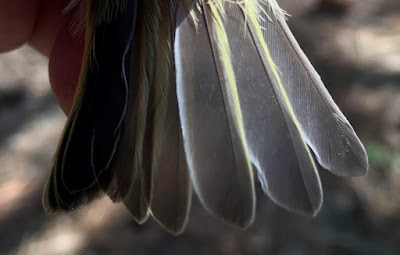A fairly quiet but typical late November day of banding with 15 new birds and 19 recaptures of 5 different species. Over the last few days, I have been collecting tail photos of Ruby-crowned Kinglets so that I could explain how we age them. Kinglets (both Ruby-crowned and Golden-crowned) can be difficult to age because they don't show any obvious molt limits. Oftentimes, we have to rely on the shape of the outer rectrices (tail feathers) in order to age them. I will also look at the shape and color of the primary coverts as they relate to the greater coverts but this can often be unreliable and difficult to discern.
The following photo shows an good example of a hatch-year kinglet. Notice that the outer tail feathers are narrow and tapered.
 |
| Ruby-crowned Kinglet (Hatch-year) |
The next photo shows the broad, rounded shape of the outer tail feathers of an adult kinglet.
 |
| Ruby-crowned Kinglet (After Hatch-year) |
This photo shows an "in-betweener". The outer tail feathers seem fairly rounded but not as truncated as an adult would be. With this individual, I specifically remember looking at the primary coverts as a secondary aging criteria. The primary coverts were pale, narrow, and tapered thus leading me to a hatch-year age determination.
 |
| Ruby-crowned Kinglet (Hatch-year) |
-Aaron
| Species | Captain Sam's | Little Bear | ||
|---|---|---|---|---|
| New | Recaps | New | Recaps | |
House Wren
|
-
|
1
|
-
|
-
|
Ruby-crowned Kinglet
|
2
|
2
|
-
|
-
|
Hermit Thrush
|
-
|
1
|
-
|
-
|
Gray Catbird
|
-
|
4
|
-
|
-
|
Yellow-rumped Warbler (Myrtle)
|
13
|
11
|
-
|
-
|
| Banding Stats | Captain Sam's | Little Bear | TOTAL |
|---|---|---|---|
| # Birds Banded |
15
|
-
|
15
|
| # of Recaptures |
19
|
-
|
19
|
| # of Species |
5
|
-
|
5
|
| Effort (net-hours) |
167.5
|
-
|
167.5
|
| Capture Rate (birds/100 net-hours) |
20.3
|
-
|
20.3
|
| # of Nets |
27
|
-
|
27
|
Banding Staff
Aaron Given (CS)

No comments:
Post a Comment